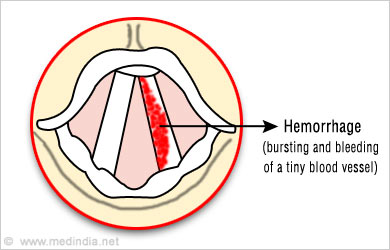Types of Voice Disorders
Structural Voice Disorders
Various structural problems can cause voice disorders. Contact ulcers, cysts, nodules, polyps, etc are some of the well known structural lesions causing voice disorders. These lesions also cause pain in the throat region. The position of the lesions affects the quality of voice produced.

Voice symptoms resulting from structural lesions in the vocal folds include:
- Breathy voice due to improper closure of the vocal folds
- Rough or harsh voice
- Vocal fatigue, worsening of voice with increased use
- Pain and discomfort with talking
- Throat irritation, with a feeling to cough it out
Infection of the larynx, or laryngitis, hyperkeratosis of vocal folds and papilloma are some other types of structural voice disorders.
Hemorrhage (bursting and bleeding of a tiny blood vessel) within the vocal fold can cover up the mucosal layer of the membrane. The fold may become stiff and vibration is difficult, resulting in weak and breathy voice. However, as the blood accumulation subsides, the voice gets back to normal. Small hemorrhages usually go unnoticed until they become severe. Usually, voice rest is advised accompanied by supportive treatments for hemorrhage.

Surgical removal of larynx and vocal cords to treat conditions such as laryngeal cancer, results in total loss of voice. Speech therapy can help the person find alternate ways of producing voice.
Most structural lesions are treated by vocal rest; that is, not using the voice for some period of time. Pain killers can be prescribed if the pain is unbearable, but is generally not required. Medications such as antibiotics, anti-reflux and sometimes steroids are prescribed to reduce infection and inflammation. Ulcers and granulomas are difficult to manage as surgical removal does not guarantee a relapse of the problem. Surgery, if performed, for cysts and granulomas, needs to be supplemented with voice rest and functional voice therapy.
Functional Voice Disorders
Muscles of the larynx may not function properly, without any particular structural or organic reason. The faulty use of the muscles may result due to excessive stress. Thus, functional voice disorders are broadly termed as muscle tension dysphonia, or MTD. The term also includes a condition in which the voice sounds normal, but causes pain, discomfort or fatigue to the voice.

The symptoms of muscle tension dysphonia can be diverse, depending upon the muscles involved. The possible characteristics of voice in MTD include:
- Jerky and shaky voice
- Strained or choked voice, produced with a lot of effort to squeeze out the air while speaking
- Breaking off or sudden changes in pitch
- Weak and breathy voice
- Inability to speak loudly
- Voice becomes weaker with continuous use
Sometimes, even when there is no change in voice, the person may feel pain or discomfort in the throat area while speaking and a tight choking sensation while trying to speak. Increased use of voice may result in voice fatigue as well as tiredness of the neck muscles.
Causes of MTD are not very specific, however, some of the possible causes may be due to prolonged overuse of voice, prolonged non-use of voice as in post-surgical days, excessive use of voice even during illness or laryngitis or sometimes emotionally traumatic event. The onset of MTD may be so subtle and may go unnoticed until it becomes excessively strained and/or painful.
Treatment of muscle tension dysphonia includes a thorough evaluation by the ENT surgeon followed by functional voice therapy with a qualified speech therapist. If emotional stress is found to be one of the causes, relevant counseling is done by a clinical psychologist or counselor.
Neurogenic Voice Disorders
Voice disorders caused by problems in the central or peripheral nervous systems fall under this category.
Paralysis of the whole body, facial paralysis, hemiplegia and similar neurological conditions affects the nerves of the larynx, which in turn disturbs voice production. Paralysis of the vocal folds causes weak, breathy or rough voice or just a whisper. Diplophonic voice (two pitches sounding at the same time) is also a characteristic feature of vocal cord paralysis. The individual may also have swallowing problems as the vocal cords fail to abduct and obstruct the trachea.

Laryngeal dystonia, also known as spasmodic dysphonia, is the neurologic movement disorder of the laryngeal muscles and vocal folds. The vibration of the vocal cords is apparently normal, but they spasm intermittently during speech resulting in strained, tight and strangled voice with sudden stoppages of the sound. Fatigue associated with the strain to use the voice usually occurs, to the extent of making speech almost unintelligible.
Benign essential tremor is a voice disorder characterized by shaky or wobbling of voice that ranges from gentle voice to a staccato and hiccupping sound. The voice is steadily rhythmic, but may vary in pitch and volume and worsens with stress. Voice fatigue is seen with increased use of voice. This condition is caused by problem in the central nervous system and does not occur in association with any other tremors such as Parkinson’s disease. Functional therapy can help improve voice quality and make speech easier.
Parkinson’s disease, Myasthenia Gravis, Amyotrophic lateral sclerosis and other such neurological conditions are also associated with voice disorders, resulting from the neuro-muscular coordination problems. Functional voice therapy can be useful to make the voice production less stressful.
Psychogenic Voice Disorders
Conversion dysphonia is a voice disorder resulting from physical manifestation of a psychological trauma or conflict. The individual may have experienced or witnessed a shocking event such as accident or death of a dear one, or sexual abuse. Functional therapy for voice control will be successful only if the underlying psychological condition is looked into.

Puberphonia, also known as Mutational falsetto or Juvenile voice, is a psychological manifestation of voice disorder when there is a tendency to resist the maturing and lowering pitch of the adult voice. The individual maintains the higher pitch of his preadolescent years. Sometimes, conditions such as upper respiratory infection or intubation at the time of puberty may be detrimental to the typical “breaking” of voice in the adolescent boys. Functional voice therapy, in such situations, is the key to success in changing the voice to a natural pitch.
Androphonia is characterized by abnormally low pitched voice in females, the reason for which is unknown. This condition can also be corrected.












